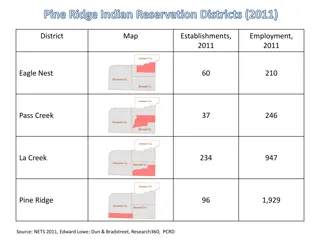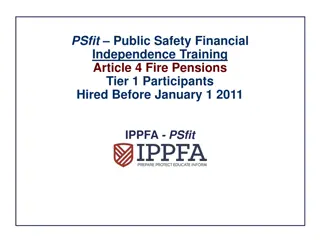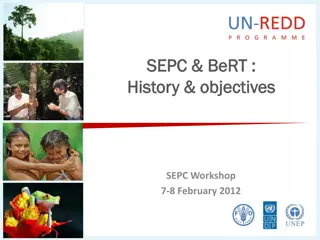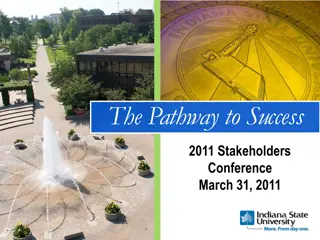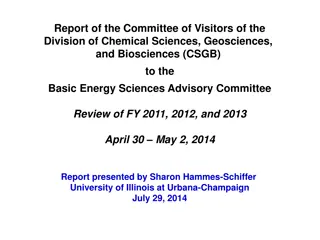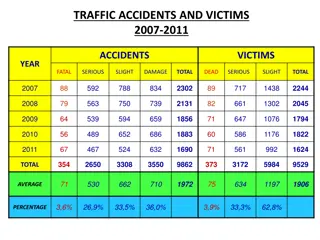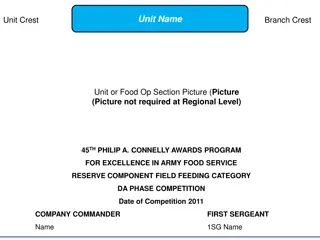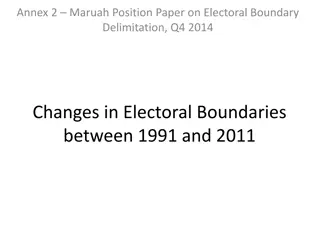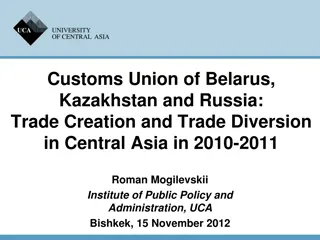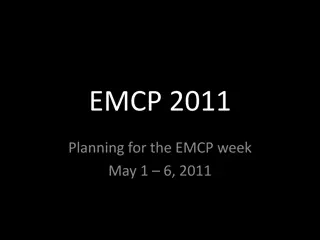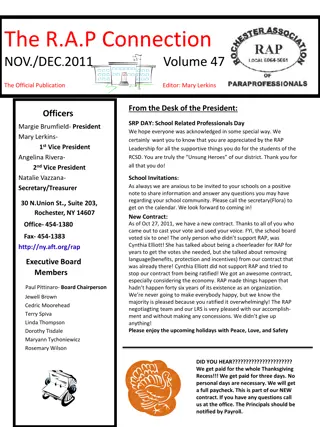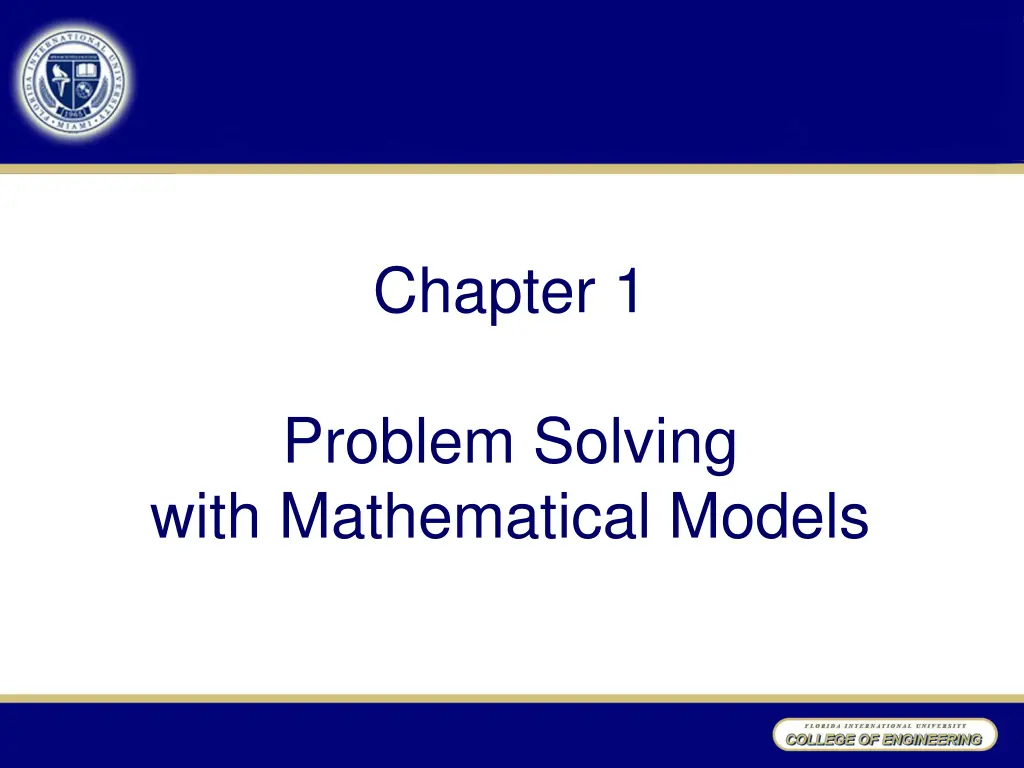
Problem Solving with Mathematical Models
Explore the use of mathematical models in solving complex problems, illustrated through the story of Mortimer Middleman and his wholesale diamond business. Follow along as operations research techniques are applied to analyze customer demand, inventory levels, costs, and profit considerations in making informed business decisions. Discover the insights gained from mathematical modeling in addressing practical challenges.
Download Presentation

Please find below an Image/Link to download the presentation.
The content on the website is provided AS IS for your information and personal use only. It may not be sold, licensed, or shared on other websites without obtaining consent from the author. If you encounter any issues during the download, it is possible that the publisher has removed the file from their server.
You are allowed to download the files provided on this website for personal or commercial use, subject to the condition that they are used lawfully. All files are the property of their respective owners.
The content on the website is provided AS IS for your information and personal use only. It may not be sold, licensed, or shared on other websites without obtaining consent from the author.
E N D
Presentation Transcript
Chapter 1 Problem Solving with Mathematical Models
Mathematical Model A mathematical model is the collection of variables and relationships needed to describe pertinent features of such a problem. Operations Research (OR) [1.1] Is the study of how to form mathematical models of complex engineering and management problems and how to analyze them to gain insight about possible solutions.
EXAMPLE 1.1: Mortimer Middleman Mortimer Middleman--friends call him MM--operates a modest wholesale diamond business. Several times each year MM travels to Antwerp, Belgium, to replenish his diamond supply on the international market. The wholesale price there averages approximately $700 per carat, but Antwerp market rules require him to buy at least 100 carats each trip. Mortimer and his staff then resell the diamonds to jewelers at a profit of $200 per carat. Each of the Antwerp trips requires 1 week, including the time for Mortimer to get ready, and costs approximately $2000.
EXAMPLE 1.1: Mortimer Middleman Customer demand values in Figure 1.1(a) show that business has been good. Over the past year, customers have come in to order an average of 55 carats per week. Demand 120 100 80 60 40 20 0 1 3 5 7 9 11 13 15 17 19 21 23 25 27 29 31 33 35 37 39 41 43 45 47 49 51
EXAMPLE 1.1: Mortimer Middleman Part (c) of Figure 1.1 illustrates Mortimer s problem. Weekly levels of on-hand diamond inventory have varied widely, [Figure 1.1(c)] 500 450 400 350 300 250 200 150 100 50 0 1 3 5 7 9 11 13 15 17 19 21 23 25 27 29 31 33 35 37 39 41 43 45 47 49 51
EXAMPLE 1.1: Mortimer Middleman depending on the ups and downs in sales and the pattern of MM s replenishment trips [Figure 1.1(b)]. Repl. 450 400 350 300 250 200 150 100 50 0 1 3 5 7 9 11 13 15 17 19 21 23 25 27 29 31 33 35 37 39 41 43 45 47 49 51
EXAMPLE 1.1: Mortimer Middleman Sometimes Mortimer believes that he is holding too much inventory. The hundreds of carats of diamonds on hand during some weeks add to his insurance costs and tie up capital that he could otherwise invest. MM has estimated that these holding costs total 0.5 % of wholesale value per week (i.e., 0.005 x $700 = $3.50 per carat per week). At other times, diamond sales and Mortimer s $200 per carat profit have been lost because customer demand exceeded available stock [see Figure 1.1(d)]. When a customer calls, MM must either fill the order on the spot or lose the sale.
EXAMPLE 1.1: Mortimer Middleman Lost_sales 50 45 40 35 30 25 20 15 10 5 0 1 3 5 7 9 11 13 15 17 19 21 23 25 27 29 31 33 35 37 39 41 43 45 47 49 51 [Figure 1.1(d)].
EXAMPLE 1.1: Mortimer Middleman Adding this all up for the past year, MM estimates holding costs of $38,409, unrealized profits from lost sales of $31,600, and resupply travel costs of $24,000, making the annual total $94,009. Can he do better?
1.2 Optimization and the Operations Research Process Problem Assessment Modeling Decisions Model Inference Analysis Conclusions
3 Dimension of the Problem The decisions open to the decision makers The constraints limiting decision choices The objectives making some decisions preferred to others [1.2]
EXAMPLE 1.1: Mortimer Middleman Decisions: reorder point, order quantity Constraints: non-negative, order quantity > 100 Objectives: to minimize total cost (holding + replenishment + lost-sale)
Optimization and Mathematical Programming Optimization models (also called mathematical Programs) represent problem choices as decision variables and seek values that maximize or minimize objective functions of the decision variables subject to constraints on variable values expressing the limits on possible decision choices. [1.3]
EXAMPLE 1.1: Mortimer Middleman Decision Variables: q reorder quantity r reorder point ( means is defined to be ) Constraints: q 100 r 0 Objective function: c(q, r) total cost using a reorder quantity of q and a reorder point r
Constant-Rate Demand Assumption Demand 120 100 80 60 40 20 0 1 3 5 7 9 11 13 15 17 19 21 23 25 27 29 31 33 35 37 39 41 43 45 47 49 51 Assume constant-rate demand of 55 carats/wk
Inventory with safety stock Inventory slope=d q r safety stock Time q/d l
Inventory without safety stock or lost sales Inventory slope=d q r Time l q/d
Inventory with lost sales Inventory slope=d q r Lost sales Time l q/d
EXAMPLE 1.1: Constant-Rate Demand Model ? ?? +? ?+???? Minimize ? = ?.?? ?? (1.1) ? Subject to q 100 r 55
Feasible and Optimal Solutions A feasible solution is a choice of values for the decision variables that satisfies all constraints. (e.g. q=200, r=90) Optimal solutions are feasible solutions that achieve objective function value(s) as good as those of any other feasible solutions. [1.4]
EXAMPLE 1.1: Constant-Rate Demand Model r* = 55 ?(?,?) ?.?? ? ?+ ???? ? ?? (1.2) ?(????)(??) ?.?? q = ???.?
EXAMPLE 1.1: Constant-Rate Demand Model TC2 $1,400.00 $1,200.00 $1,000.00 $800.00 $600.00 $400.00 $200.00 $- 100 110 120 130 140 150 160 170 180 190 200 210 220 230 240 250 260 270 280 290 300 310 320 330 340 350 360 370 380 390 400 410 420
1.3 System Boundaries, Sensitivity Analysis, Tractability, and Validity System boundary Modeling and Analysis in the decision variables Parameters Output variables
EOQ Under Constant-Rate Demand Parameters: d weekly demand (55 carats) f fixed cost of replenishment ($2000) h cost per carat per wk for holding inventory ($3.50) s cost per carat of lost sales ($200) l lead time between reaching the reorder point and receiving a new supply (1 week) m minimum order size (100 carats)
EOQ Under Constant-Rate Demand Decision variables (if lost sales are not allowed): [1.5] ??? ? optimal order quantity q* = optimal reorder point r* = ?? Provided q* m q* ??
Sensitivity Analysis Sensitivity analysis is an exploration of results from mathematical models to evaluate how they depend on the values chosen for parameters. [1.6]
Sensitivity Analysis $2,000.00 $1,800.00 $1,600.00 $1,400.00 f=$3000 $1,200.00 f=$2000 $1,000.00 $800.00 f=$1000 $600.00 $400.00 $200.00 $- 100 110 120 130 140 150 160 170 180 190 200 210 220 230 240 250 260 270 280 290 300 310 320 330 340 350 360 370 380 390 400 410 420
Closed-Form Solutions Closed-form solutions represent the ultimate in analysis of mathematical models because they provide both immediate results and rich sensibility analysis. [1.7]
Tractability versus Validity Tractability in modeling means the degree to which the model admits convenient analysis how much analysis is practical. [1.8] Validity of a model is the degree to which inference drawn from the model hold for the real system. [1.9] OR analysts almost always confront a tradeoff between validity of models and their tractability to analysis. [1.10]
1.4 Descriptive Models and Simulation A simulation model is a computer program that simply steps through the behavior of a system of interest and reports experience.
Simulation over MMs History Repl. 300 250 200 150 100 50 0 1 3 5 7 9 11 13 15 17 19 21 23 25 27 29 31 33 35 37 39 41 43 45 47 49 51 Lost_sales 70 60 50 40 30 20 10 0 1 3 5 7 9 11 13 15 17 19 21 23 25 27 29 31 33 35 37 39 41 43 45 47 49 51
Simulation over MMs History Inventory Level 300 250 200 150 100 50 0 1 2 3 4 5 6 7 8 9 10111213141516171819202122232425262728293031323334353637383940414243444546474849505152 Total Cost: $108,729.75
Simulation Model Validity Simulation models often possess high validity because they track true system behavior fairly accurately.
Descriptive versus Prescriptive Models Descriptive Models evaluate fixed decision alternatives rather than indicating good choices. Descriptive Models yield fewer analytical inferences than prescriptive, optimization models because they take both input parameters and decisions as fixed.
1.5 Numerical Search and Exact versus Heuristic Solutions c(q,r) total cost computed by simulation with reorder point fixed at r andreorder quantity at q MM s problem than reduces to the math model: minimize c(q,r) subject to q 100, r 0 (1.3)
Numerical Search Numerical search is the process of systematically trying different choices for the decision variables, keeping track of the feasible one with the best objective function value found so far.
Numerical Search q(0)= 251, r(0)= 55, c(q(0), r(0)) = $108,621 q(1)= 251, r(1)= 65, c(q(1), r(1)) = $108,421 q(2)= 251, r(2)= 75, c(q(2), r(2)) = $63,254 q(3)= 251, r(3)= 85, c(q(3), r(3)) = $63,054 q(4)= 251, r(4)= 95, c(q(4), r(4)) = $64,242 increasing q q(5)= 261, r(5)= 85, c(q(5), r(5)) = $95,193 decreading q q(6)= 241, r(6)= 85, c(q(6), r(6)) = $72,781 STOP q(3)= 251, r(3)= 85, c(q(3), r(3)) = $63,054
Numerical Search A Different Start q(0)= 251, r(0)= 145, c(q(0), r(0)) = $56,904 q(1)= 251, r(1)= 155, c(q(1), r(1)) = $59,539 decreading r q(2)= 251, r(2)= 135, c(q(2), r(2)) = $56,900 q(3)= 251, r(3)= 125, c(q(3), r(3)) = $59,732 increasing q q(4)= 261, r(4)= 135, c(q(4), r(4)) = $54,193 q(5)= 271, r(5)= 135, c(q(5), r(5)) = $58,467 STOP q(4)= 261, r(4)= 135, c(q(4), r(4)) = $54,193
Numerical Search Inferences from numerical search are limited to specific points explored unless mathematical structure in the model supports further deduction. [1.13]
Exact versus Heuristic Optimization An exact optimal solution is a feasible solution to an optimization model that is provably as good as any other in objective function value. A heuristic or approximate optimum is a feasible solution derived from perspective analysis that is not guaranteed to yield an exact optimum. [1.14] Losses from settling for heuristic instead of exact optimal solutions are often dwarfed by variations associated with questionable model assumptions and doubtful data. [1.15] The appeal of exact optimal solutions is that they provide both good feasible solutions and certainty about what can be achieved under a fixed set of model assumptions. [1.16]
1.6 Deterministic versus Stochastic Models A mathematical model is termed deterministic if all parameter values are assumed to be known with certainty, and probabilistic or stochastic if it involves quantities known only in probability. [1.17]
Random Variables and Realizations Random variables (in Caps) represent quantities known only in terms of a probability in stochastic models. Frequency 16 14 12 10 8 6 4 2 0 10 20 30 40 50 60 70 80 90
Stochastic Simulation (Monte Carlo Analysis) 1. Randomly generating a sequence of realizations for input parameters. 2. Simulating each realization against chosen values for the decision variables. Besides providing only descriptive analysis, stochastic simulation models impose the extra analytic burden of having to estimate results statistically from a sample of system realizations. [1.18]
Tradeoffs between Deterministic and Stochastic Models The power and generality of available mathematical tools for analysis of stochastic models does not nearly match that available for deterministic models. [1.19] Most optimization models are deterministic not because OR analysts really believe that all problem parameters are known with certainty, but because useful prescriptive results can often be obtained only if stochastic variation is ignored. [1.20]
1.7 Perspectives Informal <> Formal models Validity <> Tractability Other considerations: understood, time frame, computer power, data collection The model-based OR approach to problem solving works best on problems important enough to warrant the time and resources for a careful study. [1.21]

